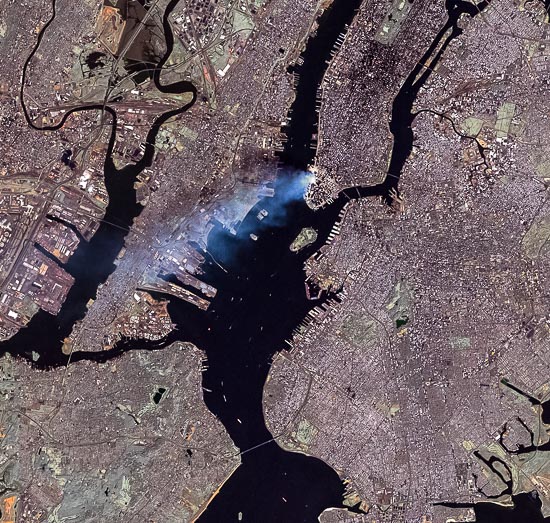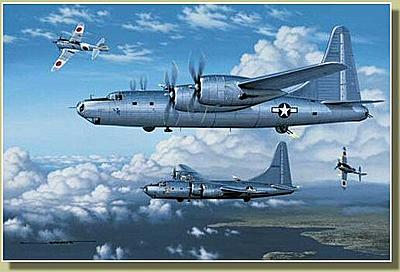Tonight Obama must be contemplating how much he feels like Stalin on June 22, 1941. One wishes it won’t take him 10 days to reappear. Until one considers how craven he will be when he does reappear. He’s no Uncle Joe, that’s for sure.
War and Peace
9/11 Plus Fourteen Years
 (Image source.)
(Image source.)I guess I thought they were all gone, those types of monsters, stranded on reels of black and white film.—Cara Ellison (blog no longer available), in a 2007 post about 9/11/01.
Bookworm: “My life is divided into two parts: Before September 11, 2001 and after September 11, 2001.”
Simply evil: Christopher Hitchens suggests that sometimes the simple and obvious explanation for an event is more accurate than an explanation which relies on an elaborate structure of “nuance”
An attack, not a disaster or a tragedy. George Savage explains why the persistent use of terms like “tragedy” by the media acts to obfuscate the true nature of the 9/11 attacks. Much more on this from Mark Steyn
Claire Berlinski was in Paris on 9/11. Shortly thereafter she wrote this piece for City Journal
Marc Sasseville and Heather Penney were F-16 pilots with an Air National Guard squadron. Their order was to bring down Flight 93 before the terrorists in control of it could create another disaster on the scale of the World Trade Center…but their aircraft were configured for training, with no live ammunition and no missiles. A video interview with Major Penney here
Joseph Fouché writes about how the Taliban’s destruction of the Bamiyan Buddhas in March 2001, and the murder of Ahmed Shah Masood on September 9 of that year, prefigured the 9/11 attacks.
The Diplomad posts a speech he gave on 9/14/01, when he was charge d’affaires at a U.S. embassy. You will not hear speeches like that being given by diplomats under the administration of Barack Obama.
On September 11, 2005, Rare Kate didn’t go to church. Follow the link to find out why. In my original post linking this, I said “What if American and British religious leaders had responded the depradations of Naziism in the spirit of this liturgy? Actually, some of them did. The impact on preparedness was certainly malign, and the people who took such positions certainly bear a share of moral resposibility for the deaths and devastation that took place. Ditto for those who are behaving in a similar way today.”
Dietrich Bonhoeffer, an important leader of the anti-Nazi resistance in Germany (executed in 1945), wrote the following:
Today there are once more saints and villains. Instead of the uniform grayness of the rainy day, we have the black storm cloud and the brilliant lightning flash. Outlines stand out with exaggerated sharpness. Shakespeare’s characters walk among us. The villain and the saint emerge from primeval depths and by their appearannce they tear open the infernal or the divine abyss from which they come and enable us to see for a moment into mysteries of which we had never dreamed.
The refusal on the part of many individuals to face the seriousness of the radical Islamist threat to out civilization stems in significant part, I feel certain, from a desire to avoid the uncomfortable and even dangerous kind of clarity that Bonhoeffer was talking about.
“The Medical History of the American Civil War”
Happy V-J Day, at 70 Years Plus a Day
While the time pressures of work and family life prevented me from posting this yesterday, Sept 02, 2015, a commemoration of the official surrender of Japan in WW2 is still in order. Like the commemoration of the atomic bombing of Japan, this post will be about how the events leading to the surrender have been covered in American culture. Specifically, it will be a posting of several C-Span network video links to presentations by the leading historians of the period including Craig Symonds, Richard Frank, D.M. Giangreco, and John Kuehn. Afterwards I will give short reviews of each video.
The following symposia video titles & descriptions, plus links, are from C-Span
1. Pacific War Turning Point
June 8, 2013
http://www.c-span.org/video/?313164-1/pacific-war-turning-point
Historians talked about the turning point in the Pacific theater
during World War II.”‚Craig Symonds argued the Battle of Midway was the
decisive engagement that shifted momentum in the Allies favor, while
Richard Frank asserted that the Guadalcanal campaign thwarted future
Axis plans and resulted in a permanent blow to the Japanese war
machine.”‚A video clip from “Victory at Sea” was played without sound.
After each author made his presentation, they held a discussion and
responded to questions from members of the audience.
“Pacific War Turning Point: Midway or Guadalcanal?” was part of The
Bernard and Irene Schwartz Distinguished Speakers Series WWII & NYC of
The New York Historical Society.
2. Fall of the Japanese Empire
July 14, 2015
http://www.c-span.org/video/?327055-1/discussion-fall-japanese-empire
Richard Frank, author of Downfall: The End of the Imperial Japanese Empire
,
spoke about the events leading up to Japan’s surrender at the end of World War II.”‚He talked about American and Japanese strategies and operations in the closing months of the war, the bombing of Hiroshima and Nagasaki, Japan’s surrender, and the fall of the Japanese Empire.
3. Strategies for the Invasion and Defense of Japan
August 6, 2015
http://www.c-span.org/video/?327355-5/strategies-invasion-defense-japan
D.M. Giangreco talked about the American offensive directed at Japan’s
northernmost island, Hokkaido.”‚He also spoke about the Soviet Union’s
involvement, including the influence of logistics and diplomatic
relations.
“The Hokkaido Myth: U.S., Soviet, and Japanese Plans for Invasion” was a portion of “Endgame: August 1945 in Asia and the Pacific,” a symposium hosted by the Institute for the Study of Strategy and Politics
4. Japan’s Decision to Surrender
August 6, 2015
http://www.c-span.org/video/?327355-7/japans-decision-surrender
John Kuehn talked about Japan’s decision to surrender to Allied forces
in August of 1945.
“A Succession of Miracles: Japan’s Decision to Surrender” was a portion of “Endgame: August 1945 in Asia and the Pacific,” a symposium hosted by the Institute for the Study of Strategy and Politics.
Each of the above presentations was hugely informative. In the “Pacific War Turning Point: Midway or Guadalcanal?” argument, I side with Richard Frank on its impact on Japanese military capability. The Guadalcanal campaign hurt the Japanese far more than the “Decisive battle” of Midway. I recently received a Kindle Copy of Phillips Payson O’Brien’s How the War was Won: Air-Sea Power and Allied Victory in World War II (Cambridge Military Histories) that convinced me of the importance of Guadalcanal over Midway in terms of killing off the best Japanese naval pilots, most of whom survived Midway.
In the second video on July 14, 2015 Richard Frank basically gives a presentation drawn from his coming trilogy on the “Asia-Pacific War” that highlights the Japanese military preparations to defend Japan, including the mobilization of a 20 million strong civilian-militia to back up the military, and how important the A-bomb was as compared to the Soviet Invasion of Manchuria in getting the Japanese to surrender. Frank also speaks to the King-Nimitz efforts to challenge Olympic and the total casualties up to August 1945 and how many more would have died from starvation had the war lasted even a short time longer. Frank tends to be US Navy centric and did not think much of MacArthur’s Olympic plans.
The third video, by D.M. Giangreco of a presentation titled “The Hokkaido Myth: U.S., Soviet, and Japanese Plans for Invasion”, goes very heavily into Japanese, Soviet & American plans to alternately defend or invade the northern Japanese island of Hokkaido. Short form — The Soviets had enough American provided sealift for a light infantry division, but not enough airpower to protect it, and the available Japanese ground forces and Kamikazes would be able to make any Soviet lodgment a Pacific Anzio.
The final video, by John Kuehn, titled “A Succession of Miracles: Japan’s Decision to Surrender” goes deeply into the Japanese high command, civilian leadership and the Showa Emperor’s maneuvering to achieve a surrender. I found it particularly useful in getting a better understanding of the irrationality that dominated Japanese decision making. And the point that Kuehn made that the “Big-Six” represented the Japanese military “Moderate factions” was chilling.
The Last Man to Die in World War 2 (+70 Years)
On August 18, 1945, in a second day running of violations of the Potsdam cease fire, fighters of the Imperial Japanese Navy attacked American B-32 Dominator bombers on photo reconnaissance missions over the Tokyo area. During these attacks the last American serviceman to die in combat during World War 2 fell.

Stephen Harding’s book LAST TO DIE: a Defeated Empire, a Forgotten mission, and the Last American Killed in World War II describes in a prologue, seven numbered chapters and afterword, with index, bibliography and copious footnotes the ill-fated mission that lead to the death of Anthony James (Tony) Marchione, an Italian-American gunner-photographic assistant, over the skies of Japan.
The prologue sets up why Stephen Harding wrote the book, the first two chapters are biographies of Tony Marchione, how he came to his unit — the 386th Bombardment Group — for the mission, and a thumb nail history of the trouble plagued B-32 Dominator super-bomber’s development and combat history. The B-32 was a back up “Very Heavy Bomber” (VHB) to the B-29 Superfortress that USAF documents would not even admit was a “VHB” design post-war!
Chapters Three through Five are the set-up for and a description of the desperate fighting action that saw Tony Marchione killed by a 20mm shell while giving first aide to two other B-32 crewmen wounded in an earlier fighter attack on his B-32 plane, tail number 578.
Chapter Six focuses on General MacArthur’s wisdom in not launching immediate retaliatory strikes on the Japanese. Thus allowing The Emperor and his loyal retainers to shut down numerous mutinous air units, to include the IJN air bases where the fighters that killed Marchione were based.
Chapter Seven has the grim details of the notification of Tony Marchione’s next of kin and the mechanics of getting his personal effects, and eventually his body, to his small-town Pennsylvania home for final funeral services in 1948.
All in all I found the book satisfying both as story telling and as a foot-noted history. It has my strong buy recommendation.